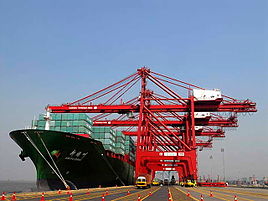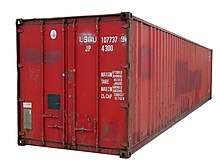Freight transport
Freight transport is the physical process of transporting commodities and merchandise goods and cargo. The term shipping originally referred to transport by sea but in American English, it has been extended to refer to transport by land or air (International English: "carriage") as well. "Logistics", a term borrowed from the military environment, is also used in the same sense.
| Admiralty law |
|---|
| History |
| Features |
| Contracts of affreightment |
| Types of charter-party |
| Parties |
|
| Judiciary |
| International conventions |
| International organisations |

Modes of shipment
In 2015, 108 trillion tonne-kilometers were transported worldwide (anticipated to grow by 3.4% per year until 2050 (128 Trillion in 2020)): 70% by sea, 18% by road, 9% by rail, 2% by inland waterways and less than 0.25% by air.[1]
Ground
Land or "ground" shipping can be made by train or by truck (British English: lorry). In air and sea shipments, ground transport is required to take the cargo from its place of origin to the airport or seaport and then to its destination because it is not always possible to establish a production facility near ports due to the limited coastlines of countries. Ground transport is typically more affordable than air, but more expensive than sea, especially in developing countries, where inland infrastructure may not be efficient.
Shipment of cargo by trucks, directly from the shipper's place to the destination, is known as a door-to-door shipment, or more formally as multimodal transport. Trucks and trains make deliveries to sea and airports where cargo is moved in bulk.
Ship
Much freight transport is done by ships. An individual nation's fleet and the people that crew it are referred to as its merchant navy or merchant marine. Merchant shipping is the lifeblood of the world economy, carrying 90% of international trade with 102,194 commercial ships worldwide. On rivers and canals, barges are often used to carry bulk cargo.
Air
Cargo is transported by air in specialized cargo aircraft and in the luggage compartments of passenger aircraft. Air freight is typically the fastest mode for long-distance freight transport, but it is also the most expensive.
Intermodal
Intermodal freight transport refers to shipments that involve more than one mode. More specifically it usually refers to the use of intermodal shipping containers that are easily transferred between ship, rail, plane and truck.
For example, a shipper works together with both ground and air transportation to ship an item overseas. Intermodal freight transport is used to plan the route and carry out the shipping service from the manufacturer to the door of the recipient.[2][3]
Terms of shipment

Common trading terms used in shipping goods internationally include:
- Free on board (FOB)[4]–the exporter delivers the goods at the specified location (and on board the vessel). Costs paid by the exporter include load, lash, secure and stow the cargo, including securing cargo not to move in the ships hold, protecting the cargo from contact with the double bottom to prevent slipping, and protection against damage from condensation. For example, "FOB JNPT" means that the exporter delivers the goods to the Jawahar lal Nehru Port, India, and pays for the cargo to be loaded and secured on the ship. This term also declares where the responsibility of shipper ends and that of buyer starts. The exporter is bound to deliver the goods at his cost and expense. In this case, the freight and other expenses for outbound traffic are borne by the importer.
- Carriage and freight (now known in the US as "cost and freight") (C&F, CFR, CNF): Insurance is payable by the importer, and the exporter pays all expenses incurred in transporting the cargo from its place of origin to the port/airport and ocean freight/air freight to the port/airport of destination. For example, C&F Los Angeles (the exporter pays the ocean shipping/air freight costs to Los Angeles). Most of the governments ask their exporters to trade on these terms to promote their exports worldwide such as India and China. Many of the shipping carriers (such as UPS, DHL, FedEx) offer guarantees on their delivery times. These are known as GSR guarantees or "guaranteed service refunds"; if the parcels are not delivered on time, the customer is entitled to a refund.
- Carriage, insurance and freight (now known in the US as "cost, insurance and freight")(CIF): Insurance and freight are all paid by the exporter to the specified location. For example, at CIF Los Angeles, the exporter pays the ocean shipping/air freight costs to Los Angeles including the insurance of cargo. This also states that responsibility of the shipper ends at the Los Angeles port.
- The term "best way" generally implies that the shipper will choose the carrier who offers the lowest rate (to the shipper) for the shipment. In some cases, however, other factors, such as better insurance or faster transit time will cause the shipper to choose an option other than the lowest bidder.
Door-to-door shipping
Door-to-door shipping is a service provided by many international shipping companies. The quoted price of this service includes all shipping, handling, import and customs duties, making it a hassle-free option for customers to import goods from one jurisdiction to another. This is compared to standard shipping, the price of which typically includes only the expenses incurred by the shipping company in transferring the object from one place to another. Customs fees, import taxes and other tariffs may contribute substantially to this base price before the item ever arrives.
See also
- Affreightment
- Automatic Identification System
- Mid-stream operation
- Outline of transport
- Ship transport
- Rail transport
- Transshipment
- Greek shipping
- Chinese shipping
- Environmental issues with shipping
- List of cargo types
- Right of way (shipping)
- Shipping markets
- Full container load (FCL)
- Less than container load (LCL)
References
- "Global Freight Demand to Triple by 2050". The Maritime Executive. May 27, 2019.
- Ltd., Core Management Logistics. "Freight Forwarding - CML". www.cmlplc.com. Retrieved 2016-11-21.
- Ltd., Mach 1 Global Logistics. "Freight Shipping Services". mach1global.com/. Retrieved 2018-01-22.
- "Shipping Glossary". Retrieved July 26, 2016.
- "Review of Maritime Transport 2014" (PDF). United Nations Conference on Trade and Development. 2014.
- "Special Chapter: Asia". Review Maritime Transport 2010 Flyer. United Nations Conference on Trade and Development. 2010. Retrieved 9 December 2011.
External links

- Schreiber, Zvi 2016: The Year Freight Goes Online. December 2015
- Humplik, Carmen Winds of change in freight transportation supply chain: Platooning technology. July 2017
- Bloomberg.com First freight deal takes Russian wheat to Turkey. January 2018
